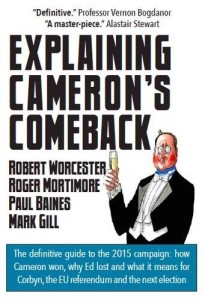Explaining Cameron’s Comeback
 Permeated with Robert Worcester’s typical breezily dismissive style, Explaining Cameron’s Comeback (written with three co-authors) is rather different from most of the other 2015 general election books such as the excellent Nuffield volume or Tim Ross’s study of the Conservative campaign.
Permeated with Robert Worcester’s typical breezily dismissive style, Explaining Cameron’s Comeback (written with three co-authors) is rather different from most of the other 2015 general election books such as the excellent Nuffield volume or Tim Ross’s study of the Conservative campaign.
That is partly because this volume focuses so much on what voters were telling pollsters rather than about what politicians were getting up to day by day, almost all of which most voters never noticed. As with Deborah Mattinson’s excellent Talking to a brick wall about an earlier political period, this is politics as voters saw it, not as politicians saw it.
It is also a different book because it goes out on a limb when it comes to how the pollsters fared in May 2015. Whilst other books will tell you how badly the pollsters did in this election, Explaining Cameron’s Comeback argues that the polls were right at the time they were conducted: “eleven different polling organisations came up with the same finding, and as they did, you must draw the conclusion that the result was solid at the time the interviews were done.” The argument in this book is that the polls were right – but then that a big chunk of Labour supporters didn’t turn out to vote on the day (the ‘lazy Labour’ explanation). That is a conclusion at odds with the results so far of the British Polling Council post-mortem, although the authors – closely connected with Ipsos-MORI – are convinced it is the explanation as to why the Ipsos-MORI’s polls – which this volume mostly relies on -were off.
However, even if there was more to what went wrong with those polls than ‘lazy Labour’, nearly all of the analysis in this book should still stand as it is about findings which are resistant to the polls being out by more than a few points. That analysis includes an expert explanation of the different theories behind how voters decide which party to pick and which is the most plausible for 2015, followed by an admirably clear set of explanations as to how pollsters go about doing their weightings and what the ‘margin of error’ really means.
The reason in the end the book concludes Cameron won? Because the Conservatives managed to hold the line in the direct Tory versus Labour contests, with no significant net loss of seats. That was based on the Conservatives winning out over Labour on both leadership and on who was seen as having the best approach to tackling people’s concerns. Labour neither managed to win on the Tory strong points (such as perceived economic competence) nor to move the agenda to other issues (such as the NHS).
However again the book’s iconoclasm features in arguing – contrary to most other political scientists – that perceptions of the government’s economic performance are heavily influenced by which party voters have decided to support (e.g. supporters of the opposition party being more likely to think that the economy is doing badly because they don’t like the government), rather than it being economic performance heavily influencing their party choice (e.g. good economic performance making people more likely to support the government).
One advantage of the book’s authors having such long involvement in psephology is that they are able to put numbers in historic context, such as highlighting how Cameron’s ratings in the 2010-15 Parliament were equal to three-times election winner Margaret Thatcher. Or that although it is true that in 1979 Labour lost despite having the more popular leader (Callaghan vs Thatcher), in fact Callaghan’s popularity lead during that Parliament had been lost in the then MORI polls by the time 1979 rolled around.
All in all, this makes the book readable and interesting even if you are not persuaded by its more controversial conclusions.
If you like this, you might also be interested in The British General Election of 2015 by Philip Cowley and Dennis Kavanagh.
Got a view on this review? Then please rate it on Amazon.
Note: a review copy of this book was provided to me by the publisher.
Leave a Reply